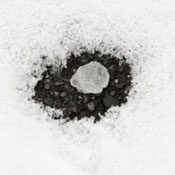Articles
Thawing Out Ice Melt Confusion
Categories: Cleaning Best Practices, Innovations, Trends & Technology
By John Holibaugh | November 27, 2018 << Back to Articles
In many parts of North America, building owners and managers are legally required to place ice melt compounds not only on immediate building entries but on nearby walkways and sidewalks as well. Typically, they turn to their jansan distributors and cleaning professionals to select the proper compounds to use and install at their facilities to promote safety and minimize their impact on floors, carpets, and the environment.
Because there are literally dozens of ice-melt compounds available and how they are used and installed can vary, this can prove to be a more difficult task than initially believed. The following is an overview of what these products are, how they work, and how to use them safely and effectively.
Ice-melt compounds are minerals that effectively reduce the freezing point of water. This is why they are used on walking surfaces during cold and adverse weather. They do this by attracting moisture to form brine, a high-salinity solution that generates heat, helping to melt the ice. Once this brine is formed, it spreads out over the surface and also helps break the bond between the ice and the surface, allowing it to be more easily removed.
Product Ingredients
Although there are many types of ice melts made by a variety of manufacturers, the active ingredients in most of these products are typically a combination of the following ingredients along with sand and clay to help promote foot traction:
- Sodium chloride. Also known as rock salt, this is the most commonly used type of ice melt. However, ironically, it has limited effectiveness in extreme cold below 20°F. It can also be corrosive to steel, certain building materials, and concrete sidewalks, as well as damaging to nearby vegetation.
- Calcium chloride. Similar to sodium chloride but more effective, calcium chloride removes moisture from the air and can work at extremely low temperatures, down to -25°F. However, it generally is more expensive than sodium chloride and also can damage nearby vegetation.
- Magnesium chloride. Comparable to calcium chloride, this compound is less corrosive and far safer to nearby vegetation.
- Potassium chloride. Although many fertilizers contain potassium chloride, when used as an ice melt, it is not necessarily safe for vegetation. The high concentration of potassium chloride makes it harmful to plants but effective at preventing ice buildup on walking surfaces. It is also less corrosive than some of the other ice-melt compounds already mentioned.
Application Best Practices
No matter which product or combination of ingredients is used, ice melts work best if they are applied before snow or ice accumulates so that they are in contact with the surface. This is why city streets are often coated with ice melt before an anticipated storm strikes. However, if applied after snow or ice has accumulated, the products can still be helpful, but will work slower with limited overall effectiveness.
Wearing gloves, apply ice melt thinly over the surface; use a fertilizer spreader for small areas or a walk-behind spreader for large areas. The entire surface does not necessarily need to be covered with ice melt. Further, the use of scoops and shovels to apply the ice melt invariably results in overuse of ice melt compounds, which can be costly and hamper performance. “Less is more” when it comes to using ice melt effectively.
Most manufacturers will list recommended amounts of ice melt to be used based on the area to be covered as well as climate conditions. If very cold weather or a severe storm is expected, manufacturers may suggest adding some water to the product to start the actual melting process more quickly. Typically, if the proper amount has been used and applied, the product will begin working within about 20 minutes.
Cleanup Issues
Although ice-melt compounds can help promote safety and their application might be legally required, they can be damaging to floor surfaces. Sodium chloride, for instance, can leave a white powdery residue if left to sit on floors over an extended period of time. Other types of ice melts can damage floor finishes and even create a surface residue that can become slippery when wet, potentially creating a hazard.
To help prevent this, cleaning professionals can remove ice melt from most floor surfaces by using a specialty product designed to remove the ice melt haze. Cleaning professionals should choose one that is a neutral pH balance cleaner and a certified green product to help protect the environment, themselves, and building occupants. The pH balance is critical; too high or too low of a pH can remove a floor’s finish while typical neutral cleaners are ineffective at thoroughly removing the ice melt haze from the floor.
First, remove any mats and thoroughly sweep or vacuum the floor area to be cleaned. Afterward, dry mop using a microfiber flat mop to remove any remaining ice melt and then apply the specialty ice melt haze remover. If using a quality product, no rinse should be required. Otherwise, the floor will need to be rinsed and rinsed again if any ice-melt residue remains on the surface.
In some cases, building managers and cleaning professionals find ice melts a necessary evil. On the one hand, they keep walkways and surfaces from becoming too slippery for foot traffic. On the other hand, their use can be damaging to structural surfaces, vegetation, and floors. But with proper selection, use, and removal, the benefits of these products can far outweigh their drawbacks.
About the Author.
John Holibaugh has been involved with the jansan industry for more than 25 years. He is a regional sales manager of Enviro-Solutions Ltd., a leading manufacturer of green cleaning chemicals, based in Ontario, Canada. For more information, visit www.enviro-solution.com.





